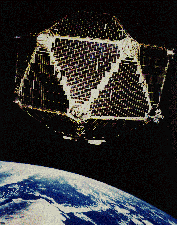Satellite Showcase
Vela 5B

Credit: NASA
|
The Mission
The Vela 5B nuclear test detection satellite was part
of a program run jointly by the Advanced Research
Projects of the U.S. Department of Defense and
the U.S.Atomic Energy Commission, managed by
the U.S. Air Force. There were 12 Vela satellites, launched in 6 pairs, put into orbit during the lifetime of the program. Vela 5A and 5B were placed into
nearly circular orbits (roughly 180 degrees apart) at a geocentric distance
of ~118,000 km on 23 May 1969; the orbital period was ~112 hours. Each
satellite rotated about its spin axis with a ~64-sec period. Identical X-ray
detectors were on each satellite, located ~90 degrees from the spin axis so
that the entire celestial sphere was observed twice per satellite orbit.
Data were telemetered in 1-sec count accumulations. Outliving its twin by a
significant period of time, Vela 5B operated until 19 June 1979, although
telemetry was often not recorded after mid-1976.
The Instrumentation
The scintillation X-ray detector (XC) aboard Vela 5B consisted of two 1-mm-
thick NaI(Tl) crystals mounted on photomultiplier tubes and covered by a
5-mil-thick beryllium window.
Electronic thresholds provided two energy channels, 3-12 keV and 6-12 keV. In
front of each crystal was a slat collimator providing a FWHM aperture of
~6.1x6.1 degrees. The effective
detector area was ~26 sq-cm. Sensitivity to celestial sources was severely
limited by the
intrinsic detector background of ~36 cts/sec. The Vela 5B X-ray detector
yielded ~40 cts/sec
for the Crab, so 1 Vela ct/sec ~25 UFU~4.5E-10 ergs/sq-cm/sec in the 3-12 keV
response band.
Both Vela 5A and 5B also carried 6 gamma-ray detectors. They had a total volume
of ~ 60 cu-cm of CsI and could detect photons in the 150-750 keV energy
range. It was in 1969-70 that these detectors on board the Vela spacecraft
first discovered gamma-ray bursts.
The Science Results
While modest in its size and limited by its high background, Vela 5B's long
lifetime afforded it unique opportunities to provide major scientific
contributions. It was one of the first satellites
to report the existence of gamma-ray bursts, and co-discovered (with
ANS) X-ray
bursts. Many papers have been published concerning the long-term
variabilities of
X-ray binaries and the appearances of X-ray
transients. The
Vela 5B light curve of one such transient, V0332+53, is shown below.

Credit: NASA
|
The ten-year light curve of the transient source V0332+53 as seen by the
Vela 5B all-sky monitor. The source became very bright in 1973, and was
not seen again until 1983.
|
The four Vela satellites (5A & B, 6A & B) recorded 73 gamma-ray bursts in the
ten year interval April 1969 - April 1979.
|
